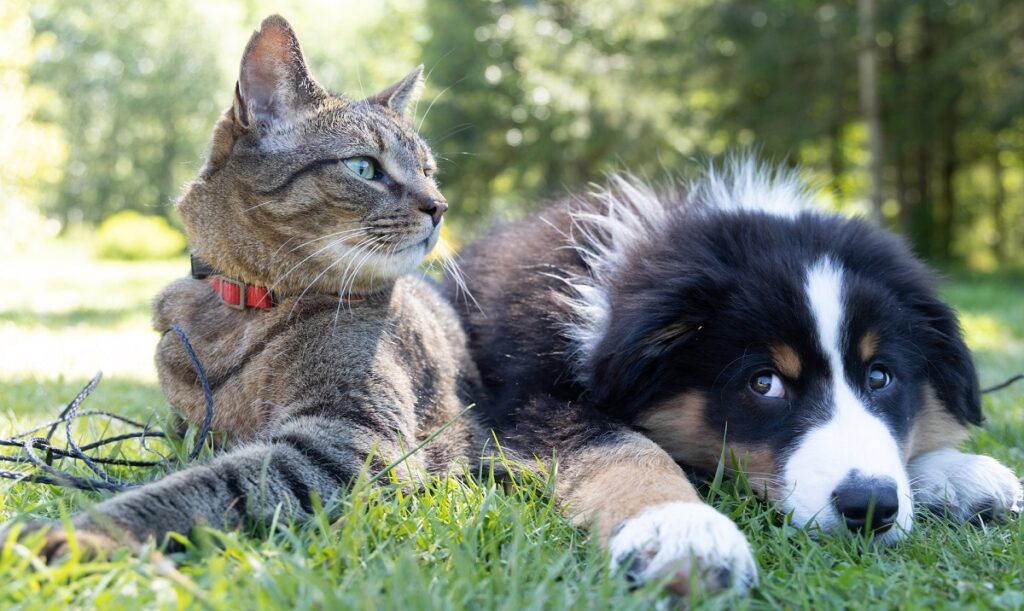It’s no secret that people love animals. Whether wild or domestic, the diversity of animals around the world is truly a wonder, so it’s no surprise that a lot of people gravitate toward pet ownership. In fact, a Forbes study just this year found that more than 66% of American households included at least one pet. That’s a lot of animals! Certainly enough that we need to be considering the combined environmental effect these pets can have.
If you’re anything like us, you might be wondering “Is there a greener way to be a responsible pet owner?” And the answer is a resounding YES.
From green grooming and natural food to cleaning up after “accidents” and getting rid of pests, you can reduce your pet’s carbon paw print and improve their overall health and quality of life. We’ve put together our top tips when it comes to caring for your four-legged family members while also being environmentally responsible.
#1. Adopt from a Shelter
If you weren’t one of the 23 million people who adopted a pet over the past two years and are considering bringing home your own furry friend, adoption is the best (and greenest) choice. There are thousands of deserving, adoptable pets at shelters and animal rescues just waiting for a loving home. Sadly, more than 6.5 million animals enter the shelter system every year, and nearly one million of those are euthanized due to space and capacity limitations. When you choose to adopt, you’re not only saving the life of a deserving animal, but you’re also helping to prevent abusive practices, such as puppy mills, and overpopulation. Search for the ideal pet friend online by checking out pet adoption sites like Petfinder, the ASPCA, and the Humane Society of America.
#2. Have Your Pet Spayed or Neutered
Pet overpopulation takes a major toll on our environment and animal welfare. In addition to the burden put on the animal rescue industry (and the numbers of animals euthanized as a result), estimates for stray animals living in the U.S. are staggering. There are upwards of 70 million stray cats alone! Do your part by spaying or neutering your pet.
#3. Keep Your Cats Inside
Cats can be a damaging force on an ecosystem. They kill as many as 3.7 billion songbirds every year worldwide; not to mention smaller mammals, amphibians, and other sensitive wildlife. To help keep these ecosystems balanced, consider making your cat indoor-only. If you have a cat who loves the outdoors, try limiting their time outside of the home to one or two hours a day.
#4. Buy Healthy Pet Food
Conventional pet foods have been known to contain some nasty ingredients, including pesticides, hormones, animal byproducts, and antibiotics. In 2007, a pet food was recalled after it was determined responsible for killing thousands of dogs and cats. And while, sure, many years later we’re certainly more mindful of what we’re putting into our pets’ bodies, the pet food industry still actively tries to push the limits of what is considered acceptable when it comes to ingredients. While the more high-end food brands can get pricey, healthy diets ultimately mean fewer vet visits and medical bills.
#5. Melt Road Ice Safely
In the dead of winter, ice is a risk for both people and animals, but rock salt (which is frequently used to thaw ice in many parts of North America) can be a significantly toxic substance if ingested or absorbed through the skin. This is as true for pets as it is for humans. Choose a pet-friendly, kid-friendly, and environmentally-friendly de-icing options such as Safe Paw to get rid of that ice in a way that won’t harm kids or pets.
#6. Get Rid of Ticks and Fleas Naturally
If your pet already has fleas, use a fine-toothed comb to remove the insects from their coat. Dust and vacuum regularly to ensure any insects they may have brought into your home are cleared out quickly. Another way to keep fleas off pets is to add garlic and brewer’s yeast to their meals, which makes the animal taste bad to bugs. You can purchase these all-natural tablets at your local pet supply store.
#7. Use Biodegradable Poop Bags
Plastic bags take hundreds of years to decompose in landfills, and many of these end up in our oceans and waterways. Buying biodegradable bags (which can decompose in roughly three months) means less plastic in landfills. You might also consider composting your pet’s poop in an outdoor pet waste composter, which removes raw waste from the environment at large. For indoor “accidents,” you can always flush the poo down the toilet rather than wrapping it up in paper or plastic and throwing it away.
#8. Buy in Bulk and Don’t Forget to Recycle
When it comes to the pet supplies you use the most, buying in bulk can cut down on packaging waste and car trips. Just like you would recycle your own food containers, make sure to add your pet’s empty cans, bags, and bottles to your recycling bin instead of the trash can.
#9. Use Natural Grooming and Pet-Care Products
Pet products like shampoos, conditioners, wet wipes—even treats—often contain toxic chemicals, so make sure to read the label before lathering up your furry friend. You can even try to make your own pet products with these helpful recipes.
#10. Buy “Green” ID Tags
No matter where you live in the U.S., pets are required to be registered with the local and/or state government in order to keep track of them. When it comes to purchasing your pet’s name tag, opt for one that is made from recycled materials like aluminum, steel, or silver. Not sure where to find one? Explore Etsy’s library of animal tag options or have fun with Dog Tag Art for creative, eco-friendly inspiration.
Just because you have a pet doesn’t mean you can’t also be eco-friendly. Sometimes, “going green” means making better decisions about the impact you have on the world around you given your circumstances. These ten tips can guide you in making conscientious decisions to be kinder to the environment (and to your pet)!




